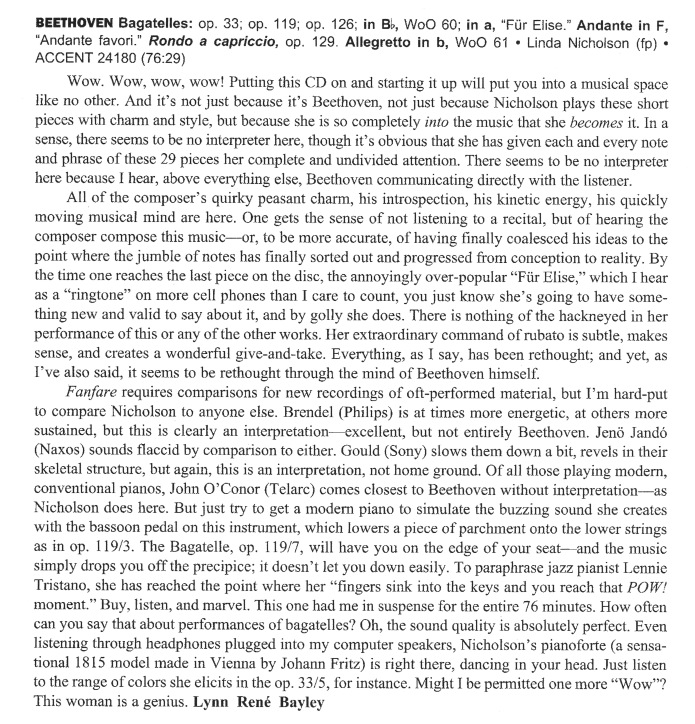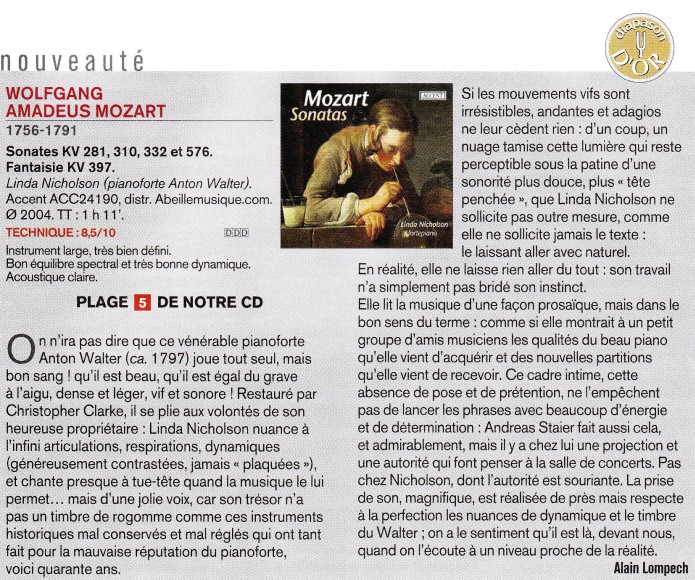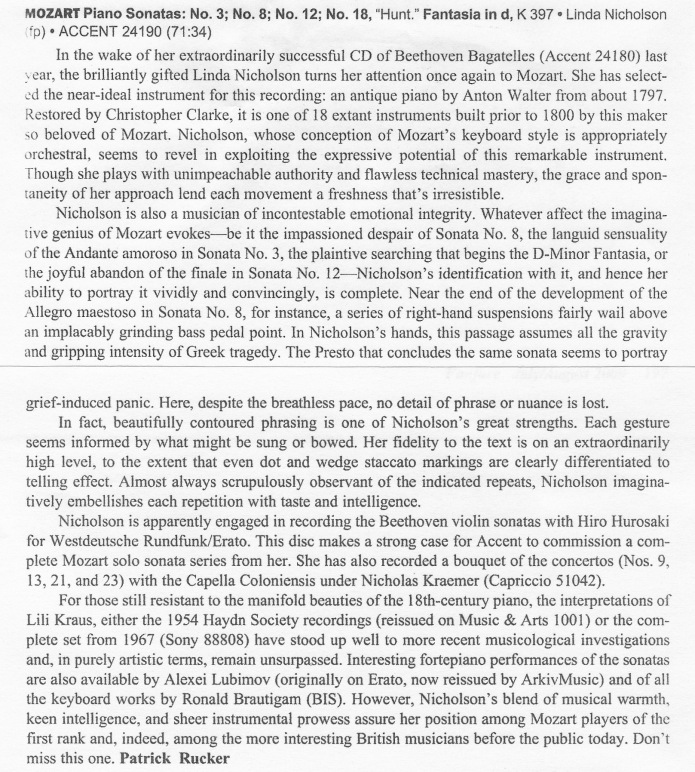|
SOLO REVIEWS Scarlatti sonatas "The sheer musicality of Linda Nicholson, extracting from the music every ounce of its worth and more. The full range of the keyboard is used and the requisite virtuosity is easily negotiated by Nicholson." MusicWeb International "Nicholson exploits the instrument to the full, showing just how expressive it can be....a highly interesting and enjoyable recital." Early Music Review, review of Scarlatti sonatas CD Beethoven Bagatelles "Linda Nicholson is an eminent performer of Classical-era repertory on keyboard instruments of the period. Nicholson's execution is as accomplished as one would expect from a performer of her calibre." Early Music Vol.37/2 2009 „ Zum Glück aber findet sich in der englischen Spezialistin für historische Tasteninstrumente Linda Nicholson eine beredte Fürsprecherin für diese Preziosen, die unter ihren Händen in bestem Lichte funkeln können." "Fortunately in Linda Nicholson, the English specialist in historical keyboard instruments, we have a strong advocate for these precious pieces, which can shine in the best light under her hands" Klassik.com 12/04/09 "An essential acquisition for anyone who takes these minor pieces seriously." Musical Pointers 
Fanfare, September/October 2008 Reviews of CD of Mozart sonatas Awarded the Diapason d'Or 
"One would not claim that this venerable fortepiano plays itself, but good heavens! How beautiful, how equal from top to bottom, rich and light, lively and resonant it is! Restored by Christopher Clarke, it bows to the wishes of its fortunate owner: Linda Nicholson is able to realise articulations,breaths, dynamics (deeply contrasted, never "veneered") with infinite nuance, and sings at the top of her voice when the music permits it...but with a lovely voice, for her instrument does not have a rasping voice like the badly-preserved and badly-regulated historical instruments that have done so much to damage the reputation of the fortepiano for some 40 years now. If the lively movements are irresistible, the andantes and adagios are no less so: suddenly a cloud covers the light that stays perceptible under the patina of a softer sound, more "head bent", which Linda Nicholson does not seek to use excessively, just as she never distorts the text: letting it flow naturally. In reality she does not let anything go: her work has simply not curbed her instinct. She reads the music in a prosaic manner, but in the good sense of the word: as if she were showing a small group of friends the qualities of the beautiful piano she has just acquired and of the new scores she has received. This intimacy, this absence of posing or pretention, do not prevent her from projecting phrases with great energy and determination: Andreas Staier does this too, and admirably, but with him there is a projection and authority which remind one of the concert hall. Not with Nicholson, whose authority is smiling. The recorded sound is magnificent, taken from close but respecting the nuances and dynamics of the Walter's timbre perfectly. We have the feeling that it is there, in front of us, when we listen at a level close to reality." Diapason, March 2009 
Fanfare, July/August 2009 C.P.E.Bach Sonatas and Clavierstücke "....this instrument seems the perfect instrument for this music in Linda Nicholson's hands. .....the three Sonatas contain the music of greatest substance, and the energetic and exciting performances they are given here show them off to best advantage. .....The other works on the disc are, as the titles of the two volumes suggest, very short, often less than a minute long. In these pieces, too, artist and instrument combine to produce stunning effects." British Clavichord Society Newsletter, February 2012 DUO REVIEWS „ Der Geiger Hiro Kurosaki und die auf den Hammerflügel spezialisierte Linda Nicholson dokumentieren gleich bei Mozarts A-Dur Sonate K. 526 ihre Extraklasse durch kantables Spiel und betörende Innigkeit. Mit Stücken von Mendelssohn und Brahms widerlegt die Pianistin anschließend das Vorurteil, der Hammerflügel klänge spröde, und Kurosaki beweist seinen Rang mit Bachs Präludium für Violine solo." " The violinist, Hiro Kurosaki, and Linda Nicholson, a fortepiano specialist, immediately proved their virtuosity by performing Mozart's Sonata in A major (K.526) with extraordinary fervour and intensity. When playing pieces by Mendelssohn and Brahms the pianist banished any prejudices against the brittle sound of a fortepiano and Kurosaki proved his high standing with his violin solo of Bach's Prelude in Emajor. Märkische Allgemeine „ Nach der Pause gestaltete Kurosaki Johann Sebastian Bachs Präludium aus der Partita Nr.3 E-Dur BWV 1006 für Violine sehr virtuos und konstruktiv, so dass der Aufbau sichtbar ward und trotzdem hinreißend musiziert wurde. Der erste Satz aus der Großen Sonate Nr.2 d-Moll Op.121 von Robert Schumann ....überaus feinfühlig interpretiert....vital und bravourös in Scherzo und Finale den Eindruck hinterlassend, wirklich authentisches Musizieren gehört zu haben....ein ganz besonderes Konzert." "After the interval Hiro Kurosaki performed Bach's Prelude from the solo Partita no.3 in E major in a very virtuosic manner, so that the structure was clear yet the playing ravishing. The first movement of the Grand Sonata no.2 in D minor (Op.121), by Robert Schumann ...was interpreted with great sensitivity throughout by both artists....The Scherzo and the Finale were both bursting with vitality and bravura so that one was left with the impression of having heard truly authentic music-making....A quite exceptional concert." Potsdamer Neueste Nachrichten The Complete Beethoven Violin Sonatas Volume 1 Opp. 47 and 96 "A journey of discovery. There could be no better introduction: this dream team is one I look forward to hearing often. Individually outstanding, truly wonderful in combination." Early Music Review, August 2009 Volume 2 Opp. 23 and 24 "Kurosaki and Nicholson give sparkling performances. I hope the remainder of the series is as much of a revelation." Early Music Review, April 2010 Volume 3 Op.12 nos. 1-3 "In such an unforgiving recorded sound world, it is all the more remarkable that both performers really "go for it." These are edge of the seat performances and the absolute security in their own vision of the works in hand is a major part of the success of these gripping accounts. The virtuosity of both is no less impressive." Early Music Review, June 2010 Further excellent reviews can be found at: www.klassik.com/magazin/reviews www.klavier.de/magazin/kritik www.klassik-heute.com www.diverdi.com : octubre 2009; febrero 2010; mayo 2010 Volume 4 Op.30 nos.1-3 Not yet reviewed. LONDON FORTEPIANO TRIO REVIEWS „ Was hier....zu hören war, ließ übliche Klaviertrio-Erlebnisse hinter sich." "What was to be heard here left the ordinary piano trio experience far behind." Claudia Valder Knechtges, Kölner Stadt-Anzeiger "The London Fortepiano Trio revealed its real purpose– genuine, unalloyed pleasure." Olga Komok, Early Music „Begeisternde Auftritte des London Fortepiano Trios in der Redoute." "Enthralling appearances by the London Fortepiano Trio in the Redoute." H.D.Terschüren, Bonner Rundschau „Kurosaki verwandelte das verzierungsreiche Rokokostück in lebendige, geistreiche Virtuosenkunst. Dass die Pianistin Linda Nicholson dem Hammerklavier die feinsten dynamischen nuancen abgewinnen kann, zeigte sie schon hier...Beethovens Trio G-Dur war der Höhepunkt des Abends. Das Spiel des Trios beglückt durch einen wunderbar vollen Klang; dazu kommt ein ausgeprägtes Bewusstsein für die Balance und Struktur des Werkes." "Kurosaki transformed the highly decorated rococo piece into lively, witty virtuosity. The pianist Linda Nicholson already showed here that she can draw the finest dynamic nuances from the fortepiano....Beethoven's G major trio was the high point of the evening. The Trio's playing pleases with its wonderful, full sound: added to that is a highly developed sense of the balance and structure of the work." General-Anzeiger |